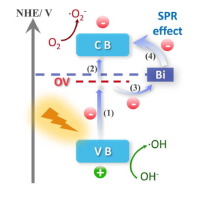Journal of Catalysis ( IF 7.3 ) Pub Date : 2017-11-20 , DOI: 10.1016/j.jcat.2017.10.004 Xing'an Dong , Wendong Zhang , Yanjuan Sun , Jieyuan Li , Wanglai Cen , Zhihao Cui , Hongwei Huang , Fan Dong

|
Charge transfer pathway and catalysis mechanism are two major issues in a specific catalytic reaction process. To further probe these two aspects of photocatalytic NO oxidation to address the environmental problem, Bi [email protected] BiOBr hierarchical microspheres were fabricated and used as a visible light photocatalyst. The interfacial and surface properties of Bi [email protected] BiOBr were optimized to understand the SPR effect of Bi metal and the oxygen vacancies (OVs) formed in situ. It was found that the charge transfer pathway on Bi [email protected] BiOBr has been significantly changed from that on pristine BiOBr. The Bi semimetal could act both as a charge transfer bridge and as a hot electron donor. The OVs induced the formation of an intermediate level in the band structure of BiOBr and promote O2 activation and thus the generation of O2− species. Due to the synergistic effects of Bi metal and OVs, Bi [email protected] BiOBr demonstrated highly enhanced visible light photocatalytic performance for NO removal. The photocatalytic NO oxidation process has been monitored by in situ diffuse reflectance infrared Fourier transform spectroscopy (DRIFTS), which could reveal the reaction intermediate products accurately. On the basis of an investigation with in situ DRIFTS and the simulation of the electronic structure, a new photocatalysis mechanism involving Bi metal, OVs, and NO transformation was proposed. The perspectives on the charge transfer pathway and photocatalysis mechanism in the present work can be extended to other catalysts for tuning the interfacial properties and enhancing the photocatalytic performance to address environmental problems.
中文翻译:

Bi [受电子邮件保护的] BiOBr分层微球上的可见光诱导的电荷转移途径和光催化机理
电荷转移途径和催化机理是特定催化反应过程中的两个主要问题。为了进一步探究光催化NO氧化的这两个方面以解决环境问题,制造了Bi [电子邮件保护] BiOBr分层微球并将其用作可见光光催化剂。对Bi(受电子邮件保护的)BiOBr的界面和表面性质进行了优化,以了解Bi金属的SPR效应和原位形成的氧空位(OVs)。发现Bi [受电子邮件保护的] BiOBr上的电荷转移途径与原始BiOBr上的电荷转移途径相比有了显着变化。铋半金属既可以充当电荷转移桥,也可以充当热电子供体。OVs诱导BiOBr的能带结构形成中间能级并促进O 2激活并由此产生Ò 2 -物种。由于Bi金属和OVs的协同作用,Bi [受电子邮件保护的] BiOBr表现出显着增强的可见光光催化性能,用于去除NO。通过原位漫反射红外傅里叶变换光谱(DRIFTS)监测了光催化NO的氧化过程,可以准确地揭示反应中间产物。在对原位DRIFTS的研究和电子结构模拟的基础上,提出了一种新的涉及Bi金属,OVs和NO转化的光催化机理。在当前工作中,关于电荷转移途径和光催化机理的观点可以扩展到其他用于调节界面性质和增强光催化性能的催化剂,以解决环境问题。

























 京公网安备 11010802027423号
京公网安备 11010802027423号